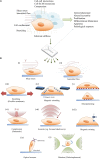Small Force, Big Impact: Next Generation Organ-on-a-Chip Systems Incorporating Biomechanical Cues
- PMID: 30356887
- PMCID: PMC6190857
- DOI: 10.3389/fphys.2018.01417
Small Force, Big Impact: Next Generation Organ-on-a-Chip Systems Incorporating Biomechanical Cues
Abstract
Mechanobiology-on-a-chip is a growing field focusing on how mechanical inputs modulate physico-chemical output in microphysiological systems. It is well known that biomechanical cues trigger a variety of molecular events and adjustment of mechanical forces is therefore essential for mimicking in vivo physiologies in organ-on-a-chip technology. Biomechanical inputs in organ-on-a-chip systems can range from variations in extracellular matrix type and stiffness and applied shear stresses to active stretch/strain or compression forces using integrated flexible membranes. The main advantages of these organ-on-a-chip systems are therefore (a) the control over spatiotemporal organization of in vivo-like tissue architectures, (b) the ability to precisely control the amount, duration and intensity of the biomechanical stimuli, and (c) the capability of monitoring in real time the effects of applied mechanical forces on cell, tissue and organ functions. Consequently, over the last decade a variety of microfluidic devices have been introduced to recreate physiological microenvironments that also account for the influence of physical forces on biological functions. In this review we present recent advances in mechanobiological lab-on-a-chip systems and report on lessons learned from these current mechanobiological models. Additionally, future developments needed to engineer next-generation physiological and pathological organ-on-a-chip models are discussed.
Keywords: in vitro organ models; lab-on-a-chip; mechanical cell actuation; mechanobiology; microfluidics; organ-on-a-chip.
Figures

Similar articles
-
Recent Advances in Additive Manufacturing and 3D Bioprinting for Organs-On-A-Chip and Microphysiological Systems.Front Bioeng Biotechnol. 2022 Feb 17;10:837087. doi: 10.3389/fbioe.2022.837087. eCollection 2022. Front Bioeng Biotechnol. 2022. PMID: 35252144 Free PMC article. Review.
-
From organ-on-chip to body-on-chip: The next generation of microfluidics platforms for in vitro drug efficacy and toxicity testing.Prog Mol Biol Transl Sci. 2022;187(1):41-91. doi: 10.1016/bs.pmbts.2021.07.019. Epub 2021 Aug 6. Prog Mol Biol Transl Sci. 2022. PMID: 35094781 Review.
-
Kidney-on-a-Chip: Mechanical Stimulation and Sensor Integration.Sensors (Basel). 2022 Sep 13;22(18):6889. doi: 10.3390/s22186889. Sensors (Basel). 2022. PMID: 36146238 Free PMC article. Review.
-
Organ-on-a-Chip and Microfluidic Platforms for Oncology in the UK.Cancers (Basel). 2023 Jan 19;15(3):635. doi: 10.3390/cancers15030635. Cancers (Basel). 2023. PMID: 36765593 Free PMC article. Review.
-
A novel organ-chip system emulates three-dimensional architecture of the human epithelia and the mechanical forces acting on it.Biomaterials. 2021 Aug;275:120957. doi: 10.1016/j.biomaterials.2021.120957. Epub 2021 Jun 6. Biomaterials. 2021. PMID: 34130145
Cited by
-
A More Biomimetic Cell Migration Assay with High Reliability and Its Applications.Pharmaceuticals (Basel). 2022 Jun 1;15(6):695. doi: 10.3390/ph15060695. Pharmaceuticals (Basel). 2022. PMID: 35745614 Free PMC article.
-
Poly-l-Lactic Acid Nanotubes as Soft Piezoelectric Interfaces for Biology: Controlling Cell Attachment via Polymer Crystallinity.ACS Appl Bio Mater. 2020 Apr 20;3(4):2140-2149. doi: 10.1021/acsabm.0c00012. Epub 2020 Mar 11. ACS Appl Bio Mater. 2020. PMID: 32337501 Free PMC article.
-
Physiological and Disease Models of Respiratory System Based on Organ-on-a-Chip Technology.Micromachines (Basel). 2021 Sep 15;12(9):1106. doi: 10.3390/mi12091106. Micromachines (Basel). 2021. PMID: 34577749 Free PMC article. Review.
-
Toward innovative approaches for exploring the mechanically regulated tumor-immune microenvironment.APL Bioeng. 2024 Feb 21;8(1):011501. doi: 10.1063/5.0183302. eCollection 2024 Mar. APL Bioeng. 2024. PMID: 38390314 Free PMC article. Review.
-
Effects of biomechanical and biochemical stimuli on angio- and vasculogenesis in a complex microvasculature-on-chip.iScience. 2023 Feb 13;26(3):106198. doi: 10.1016/j.isci.2023.106198. eCollection 2023 Mar 17. iScience. 2023. PMID: 36879808 Free PMC article.
References
Publication types
LinkOut - more resources
Full Text Sources
Other Literature Sources
Miscellaneous

